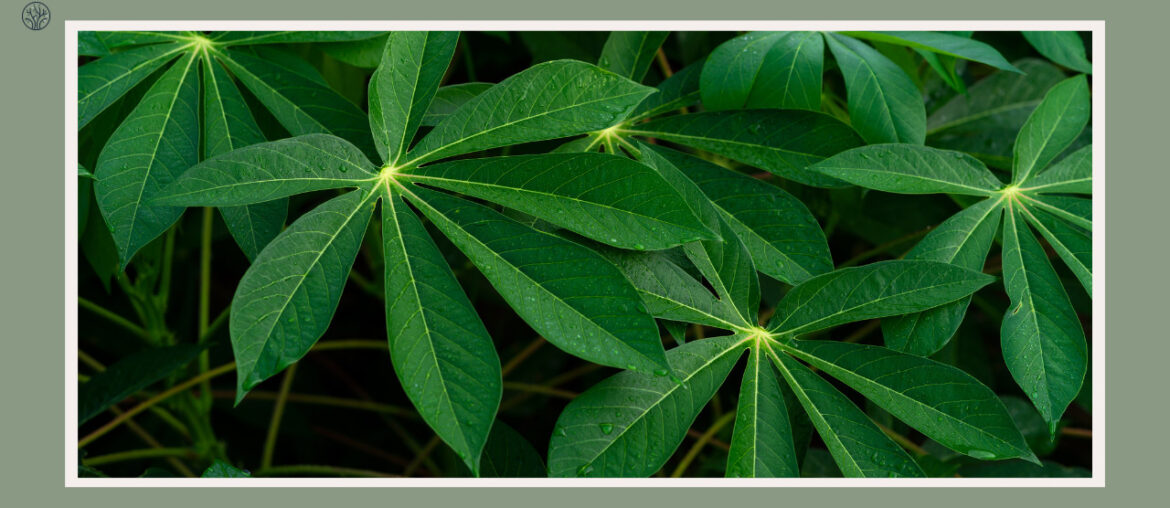Trees are amazing species. Some drop seeds that spin like helicopters, others grow weird green balls, and some even have flowers that look like cotton. But, the real interest is when different plants have similar leaves. We’ve talked before about trees with heart-shaped leaves or ones that look like ferns. Today, we’re focusing on something a bit different – plants that look like weed.
It’s fascinating how nature can make different plants look so similar. Let’s find out what these plants are
Key takeaways
- Marijuana leaves are known for their unique, serrated leaflets, forming a distinctive shape that’s recognized globally.
- One of the most distinctive features of marijuana is its strong, skunky smell.
- The most valuable part of the marijuana plant is the bud, which is a dense cluster of flowers.
- Japanese Maple, Southern Marigold, Sunn Hemp,… are trees that have similar leaf structures, growth habits, or other features that resemble those of marijuana.
1. Japanese Maple
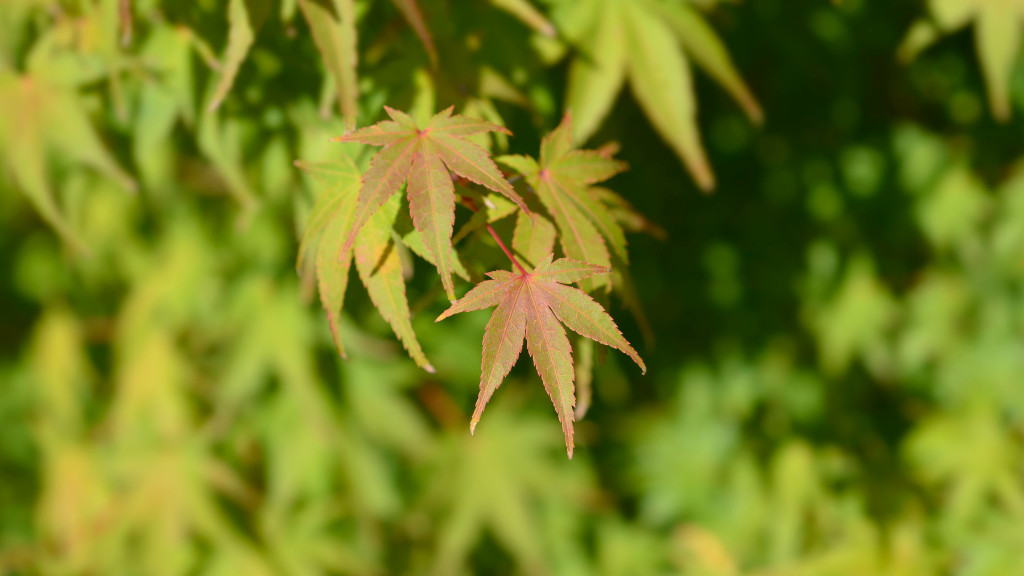
Many people confuse the Japanese Maple with marijuana because of its complex leaf shape and amazing color shifts. This resemblance is more common when the maple is young. Its leaves have a palm-like form that looks like the marijuana leaf, complete with jagged edges that match the cannabis outline.
But the Japanese Maple changes with the seasons, showing off different colors from bright greens to reds and purples. This is something that marijuana plants can’t do. The Japanese Maple’s leaves also have no hairs, unlike the cannabis leaves which have tiny hairs on the bottom. As the tree matures, its woody stem and diverse leaf coloration show its true nature, making it different from its cannabis lookalike.
2. Southern Marigold
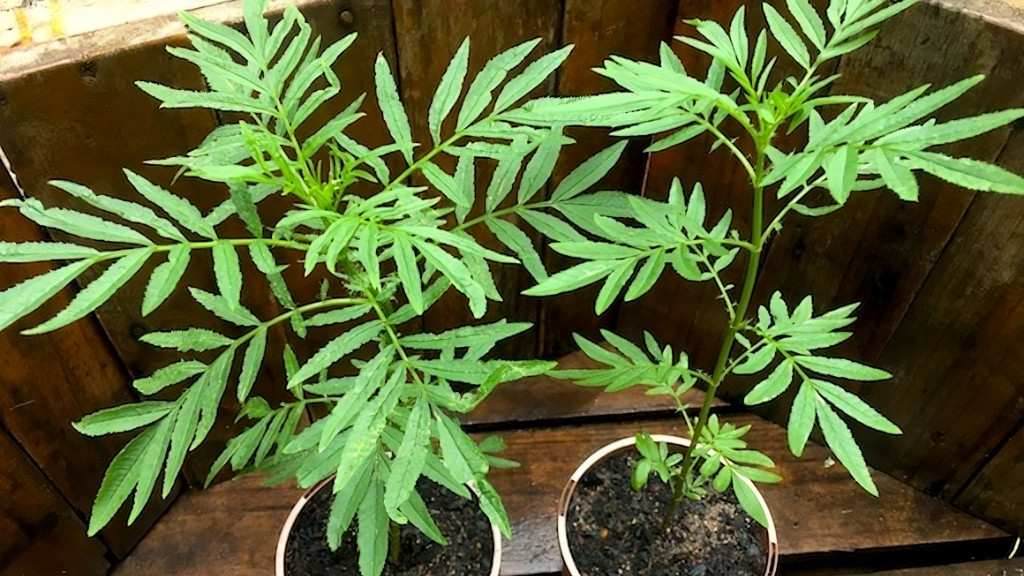
Southern Marigold is also among plants that might look like weed. Native to South America, this plant has found its way across various continents. Its long, jagged leaves are very similar to the leaves of young cannabis plants.
But if you look closer, you can see the differences. The Southern Marigold has tiny, bright yellow flowers., a stark contrast to the green and purple flowers of cannabis. Also, the marigold’s leaves are simple, not compound; each leaf connects directly to the stem, unlike the marijuana leaves that grow in groups.
3. Sunn Hemp
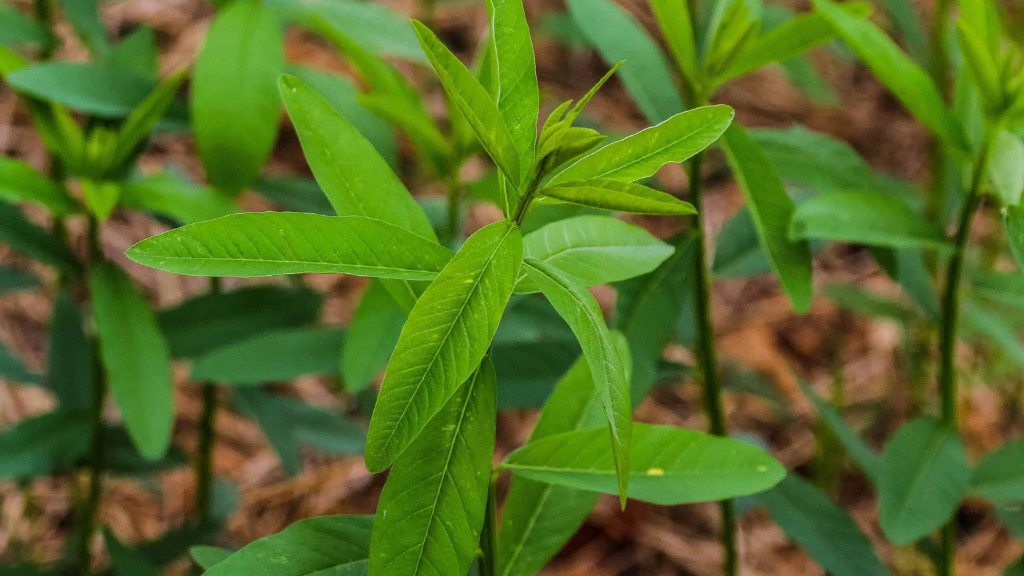
Sunn Hemp, a native to India, is often confused with cannabis due to its similar leaf structure and growth habit. It has long, jagged leaves similar to cannabis leaves. Sunn Hemp’s leaves, however, are singular and not compound like cannabis, and its bright yellow flowers are also different from the green or purple buds of marijuana.
What really sets Sunn Hemp apart is its utility in agriculture. It’s a soil-improving powerhouse, used to enhance the land with its nitrogen-fixing abilities. Unlike cannabis, which is grown for its medicinal and recreational properties.
4. Coral Plant

The Coral Plant comes from Mexico and the Caribbean is one of the plants that look like weed the most botanical twin to marijuana. Its leaves are palmate and divided into leaflets, much like cannabis. The similarities might end there, but they’re enough to give a passerby pause. The Coral Plant’s leaves have a unique lobe shape, and when it blooms, it reveals clusters of bright red flowers that are very different from the cannabis plant.
An interesting note about the Coral Plant is its sap, which is white and thick, not like cannabis. Additionally, the Coral Plant has a distinctive, somewhat off-putting smell that is very different from the aromatic qualities of cannabis.
5. Okra

Okra, a staple in Southern cooking and a common ingredient in dishes worldwide has been caught up in mistaken identity cases with cannabis. This is due to its similarly shaped leaves, which are broad, palmate, and can grow to a significant size, much like those of the cannabis plant. Confusion usually occurs when the plants are not in bloom, as okra’s flowers and seed pods are telltale signs of their true nature.
The plant’s flowers are large and can be white or yellow with a crimson center, contrasting with the small and more discreet flowers of cannabis. Okra’s fruit, the edible pod, is another clear indicator, as cannabis produces no such vegetable. Okra plants also have similar heights to weed, making them look quite identical.
6. Cassava

Cassava or yuca manioc is a plant that grows in tropical climates and has leaves that look like cannabis. Its leaves are large, palmate, and divided into lobes, which can look quite similar to those of cannabis. However, cassava leaves are not compounds like those of cannabis and have smooth edges, not jagged like cannabis.
A key difference between cassava and cannabis is their respective uses. Cassava is cultivated for its starchy tuberous roots, a vital source of carbohydrates in many tropical diets. Unlike cannabis, which is notorious for its psychoactive and medicinal properties.
7. Spider Flower

The Spider Flower, with its spiky, palmately compound leaves, is easily one of the plants that look like weed the most. The resemblance is uncanny, with both plants featuring serrated leaf margins and a similar leaf arrangement. However, the Spider Flower has bright and beautiful flowers that come in shades of pink, white, or purple, and its distinctive, sometimes pungent, odor.
Cleome is also a favorite among gardeners for its ability to attract beneficial insects. This characteristic makes it a valuable companion plant in gardens, unlike cannabis, which is typically grown in more controlled environments due to its legal status and the need for specific growing conditions.
8. Texas Star Hibiscus
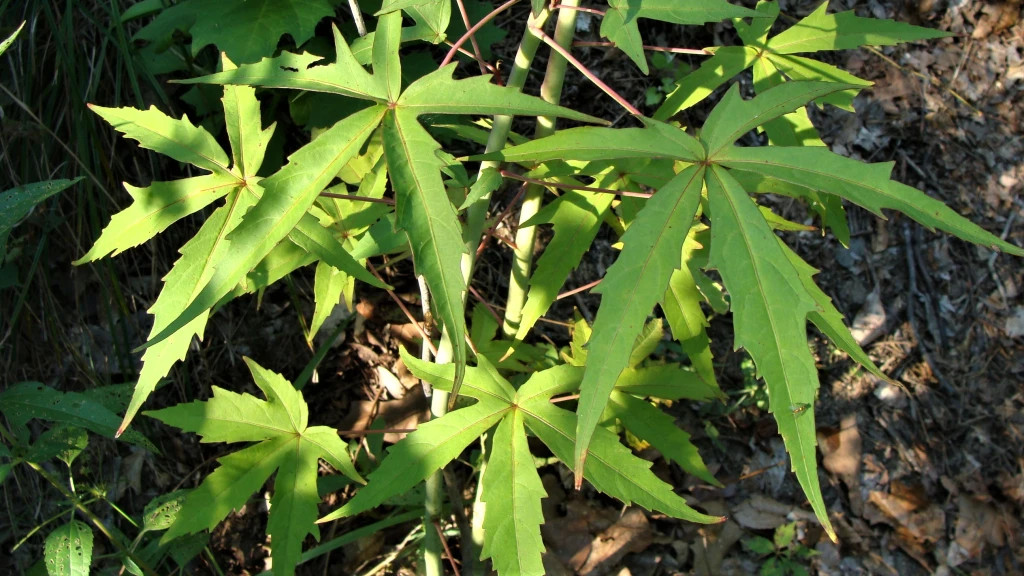
The Texas Star Hibiscus is an ornamental plant that can cause a second glance due to its cannabis-like foliage. When it is young, before it has flowers, its leaves have jagged edges and a texture like cannabis leaves. However, the Texas Star Hibiscus shows its true colors when it has beautiful, star-shaped flowers.
Another distinguishing feature of the Texas Star Hibiscus is its woody stem, which sets it apart from the softer, green stems of cannabis. Additionally, the leaves of the Hibiscus coccineus tend to droop more than those of cannabis.
9. Kenaf
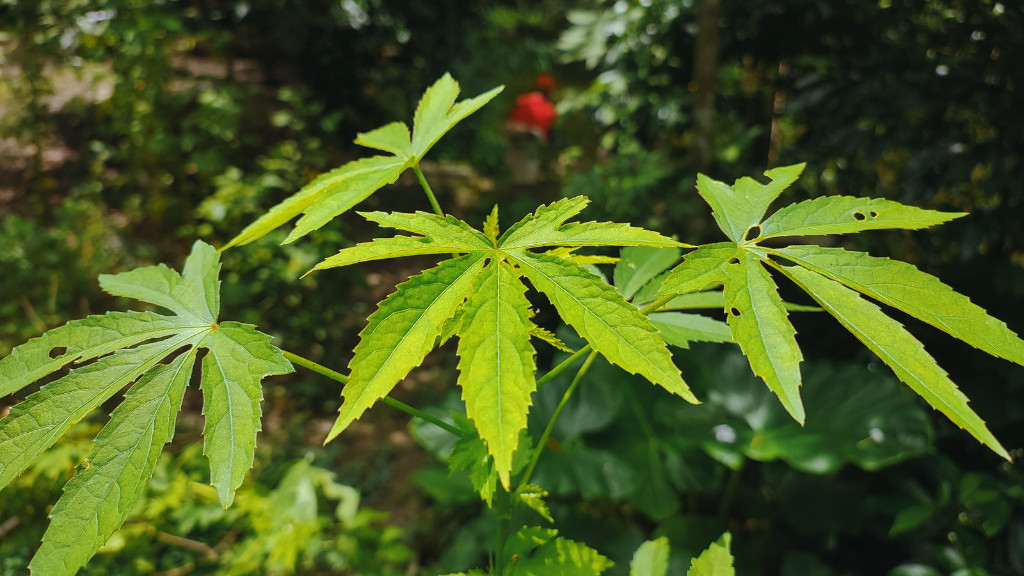
Kenaf might just be the plant with the most deceptive name in our list, given its species name “cannabinus” which is similar to cannabis. This resemblance is not just coincidence; the kenaf plant’s leaves mimic the shape and texture of cannabis leaves, especially when viewed from a distance. Kenaf’s leaves have parts and jagged edges, and the plant can grow to similar heights of cannabis.
But kenaf is different from cannabis in how people use it and how it flowers. People grow kenaf for its fibers and use it to make ropes, twines, and even bio-composite materials. Kenaf’s flowers are easy to tell apart from cannabis. They look like hibiscus flowers, with thin petals, unlike the dense buds of cannabis.
10. Chaste Tree
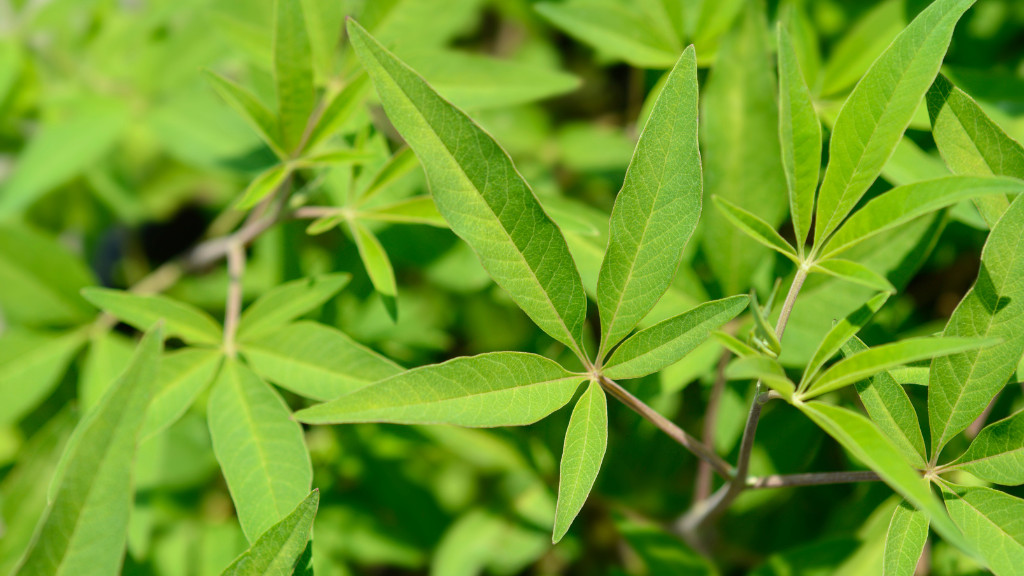
The Chaste Tree, or Vitex, is another plant that could be mistaken for marijuana due to its similar leaf structure. The leaves are palmate-like cannabis, and the plant can grow to a similar size, which adds to the confusion. However, the Chaste Tree’s leaves are longer and thinner than cannabis leaves.
The Chaste Tree has many benefits for health, especially for women. It has nice-smelling purple flowers, that are very different from the small and plain flowers of cannabis. The Chaste Tree has been used for a long time in natural medicine which sets it apart from the more recently popularized cannabis.
11. Cranberry Hibiscus
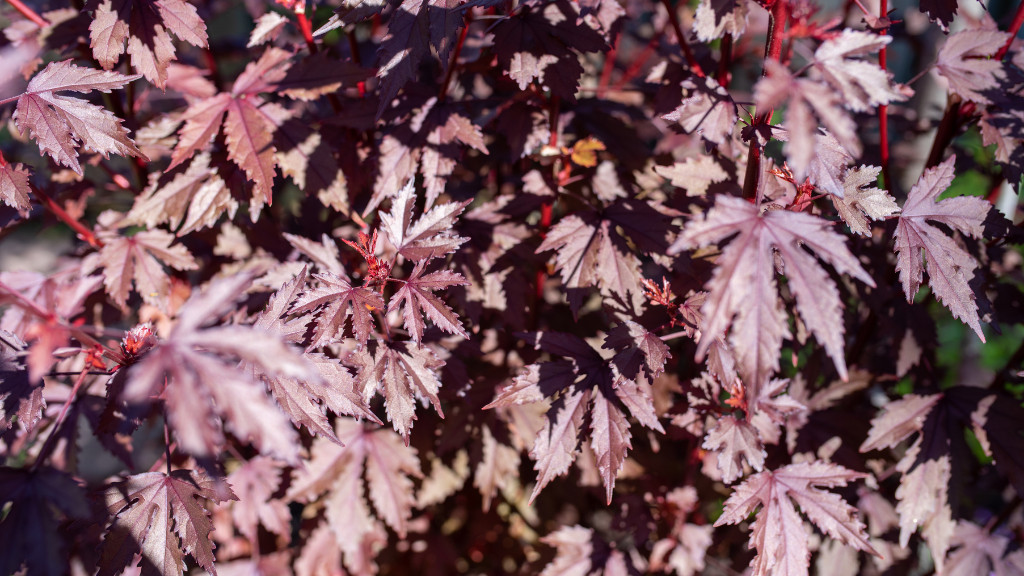
.Cranberry Hibiscus is a stunning plant that could easily be mistaken for cannabis due to its deep red, serrated leaves that resemble the shape of cannabis leaves. This resemblance is most pronounced before the plant flowers. However, Cranberry Hibiscus, a member of the Malvaceae family, quickly reveals its true colors with its vibrant, cranberry-colored foliage and edible flowers.
Unlike cannabis, the Cranberry Hibiscus is often grown as an ornamental plant or for its tangy, citrus-flavored leaves and flowers, which are used in salads and teas. Its leaves also have a glossy texture and a more intense color compared to the matte and varied green hues of cannabis leaves.
12. Mugwort

Mugwort, known scientifically as Artemisia vulgaris, is a plant with a leaf structure that can cause it to be mistaken for cannabis. Its leaves are deeply lobed and can appear somewhat similar to those of young cannabis plants. However, mugwort leaves are typically more silvery or grayish-green in color and have a fine downy texture, unlike the vibrant green and smoother texture of cannabis leaves.
Mugwort is often found in the wild and has a long history of use in herbal medicine, particularly in Europe and Asia. It’s known for its aromatic properties, with a complex scent that is quite different from the distinctive smell of cannabis. When it flowers, mugwort produces small, inconspicuous flowers that bear no resemblance to cannabis buds.
Distinguishing Features of Cannabis
While many plants do look like weed in some ways, there are distinct features unique to this plant that can help in its identification. Understanding these can prevent misidentification and clarify why these other plants are often mistaken for cannabis.
The Unique Smell
One of the most distinctive features of cannabis is its smell. Cannabis plants produce a strong, pungent odor that is often described as skunky, earthy, and sometimes with hints of citrus or pine. This aroma is due to the presence of compounds called terpenes, which are also found in many other plants but are particularly concentrated in cannabis.
Trichomes
Cannabis plants are famous for their trichomes, the tiny, crystal-like structures that cover the leaves and buds. These glandular hairs are not just decorative; they produce and store the plant’s cannabinoids and terpenes. Under a microscope, trichomes are unmistakable, resembling a forest of miniature mushrooms. They give cannabis buds a frosty appearance, which is a key indicator of the plant’s potency and a feature that is not present in the lookalike plants.
Leaf Structure
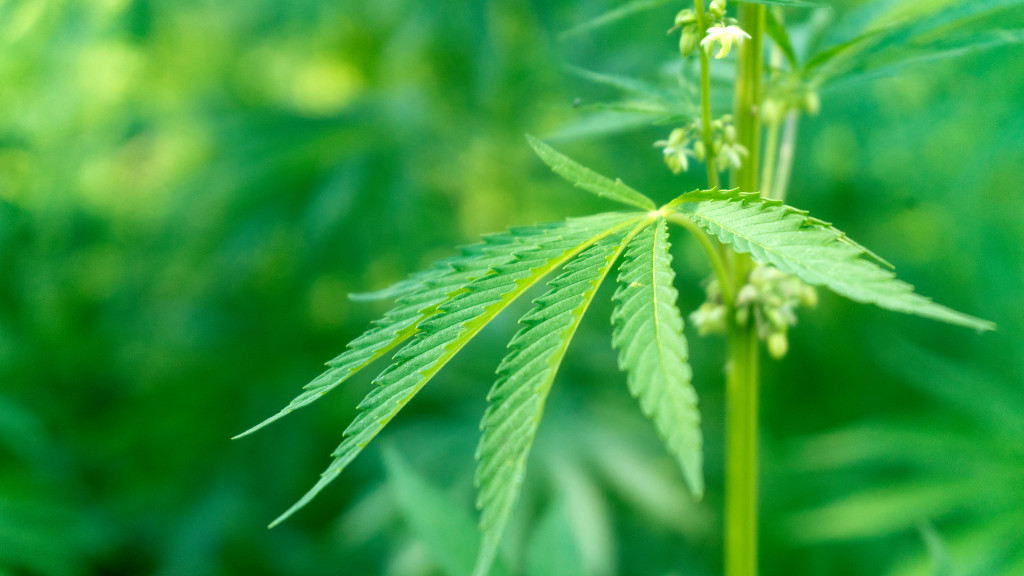
While the iconic cannabis leaf is often what leads to confusion with other plants, upon closer examination, its structure is quite unique. Cannabis leaves are compound, with multiple leaflets emanating from a single petiole. The number of leaflets can vary, but they typically have a jagged, serrated edge and a pronounced central vein.
Flowering Buds
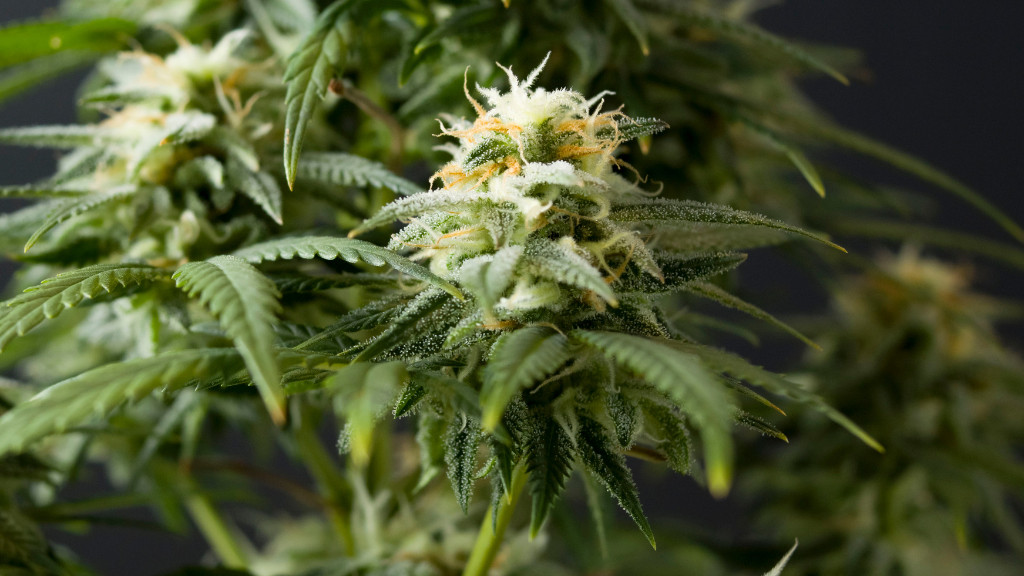
The flowering buds of cannabis are distinct and are the main reason for the plant’s cultivation. These buds are dense and compact, with a sticky texture due to the trichomes. Unlike the open and more traditional flower structure of many plants, cannabis buds are tightly clustered, with pistils and stamens hidden among the leaves.
Growth Habit
Cannabis plants can grow to significant heights, with some strains reaching up to 12 feet tall. They have a bushy appearance, with a sturdy central stem and branches that spread outwards. This growth habit can be quite different from the more delicate or sprawling nature of some of the lookalike plants.
By understanding these distinguishing features, one can more easily differentiate cannabis from other similar-looking plants and appreciate the unique characteristics that make it stand out in the plant kingdom.
FAQs
Is there a plant that looks like weed?
Yes, there are several plants that bear a resemblance to weed, or cannabis. These include the Japanese Maple, Kenaf, and the Cassava plant, among others. Their similar leaf shapes and structures can often lead to confusion, especially when these plants are not in bloom or at a young stage of growth.
What looks like weed but isn’t?
Plants like the Japanese Maple, Southern Marigold, Sunn Hemp, and Coral Plant have characteristics that are similar to cannabis, particularly their leaf structure. However, they are not related to cannabis and have different uses, ranging from ornamental to agricultural.
Are there any Chinese plants that look like weed?
The Chinese plant that is often mistaken for weed is the Chinese Hibiscus or Hibiscus rosa-sinensis. It has leaves that can look similar to cannabis leaves, but it is actually a flowering plant that produces large, colorful blooms.
What plant smells similar to weed?
There are a few plants that have a similar smell to cannabis due to their terpene content. These include certain herbs like lavender, sage, and lemon balm. However, the skunky, potent aroma of cannabis is quite unique and usually distinguishable from other plant scents.
What is the closest related plant to cannabis?
The closest relatives to cannabis are hops, which are in the same family, Cannabaceae. Hops, used primarily in the brewing of beer, share a similar chemical composition with cannabis, including the presence of terpenes, although they do not contain the cannabinoids that cannabis is known for.
Is there a cannabis type that doesn’t look like weed?
Cannabis plants can vary widely in appearance, with some strains having leaves that are less serrated and more rounded, which may not immediately be recognized as cannabis. However, most cannabis strains have the distinctive leaf shape and structure that is commonly associated with the plant.

